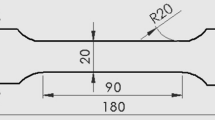Abstract
This paper presents experimental studies of rubber-pad forming process of AA5182 aluminum alloy sheet. The influences of load velocity and rubber pad height for characteristic of polyurethane rubber are investigated firstly by compression tests. It can be concluded that the load force increases quickly with decreasing of rubber pad height. The expansion diameter of polyurethane rubber is insensitive to load velocity at 40 and 60 mm height. Then the deformation characteristic of rubber-pad forming, states of strain, and stress is analyzed to compare with conventional drawing. Furthermore, AA5182 aluminum alloy sheets with thickness of 0.8 and formed target part with diameter of 80 mm and height of 15 mm are investigated under different load velocity varying from 50 to 500 mm/min. The load velocity, load force, and distribution of thickness are analyzed in detail. Results show that the maximum thickness reduction occurs at the bottom corner of the formed part. And the maximum thinning decreases to 20.0% for v = 50 mm/min, 20.0% for v = 100 mm/min, 17.5% for v = 300 mm/min, and 17.5% for v = 500 mm/min. At last, the forming process for target part with diameter of 80 mm and height of 20 mm is also investigated under different load velocity. The results confirmed that it is difficult to form the desired shape.
Similar content being viewed by others

References
Allwood JM, Shouler DR (2009) Generalised forming limit diagrams showing increased forming limits with non-planar stress states. Int J Plast 25(7):1207–1230. https://doi.org/10.1016/j.ijplas.2008.11.001
Lang LH, Wang YM, Xie YS, Yang XY, Xu YQ (2012) Pre-bulging effect during sheet hydroforming process of aluminum alloy box with unequal height and flat bottom. Trans Nonferrous Met Soc Chin 22:302–308
Cui XL, Wang XS, Yuan SJ (2014) Deformation analysis of double-sided tube hydroforming in square-section die. J Mater Process Technol 214(7):1341–1351. https://doi.org/10.1016/j.jmatprotec.2014.02.005
Zhang FF, Li XF, Xu YC, Chen J, Chen JS, Liu G, Yuan SJ (2015) Simulating sheet metal double-sided hydroforming by using thick shell element. J Mater Process Technol 221:13–20. https://doi.org/10.1016/j.jmatprotec.2015.02.001
Aksenov SA, Chumachenko EN, Kolesnikov AV, Osipov SA (2015) Determination of optimal gas forming conditions from free bulging tests at constant pressure. J Mater Process Technol 217:158–164. https://doi.org/10.1016/j.jmatprotec.2014.11.015
Maeno T, Mori K, Adachi K (2014) Gas forming of ultra-high strength steel hollow part using air filled into sealed tube and resistance heating. J Mater Process Technol 214:97–105
Wang KH, Liu G, Zhao J, Wang JL, Yuan SJ (2016) Formability and microstructure evolution for hot gas forming of laser-welded TA15 titanium alloy tubes. Mater Des 91:269–277. https://doi.org/10.1016/j.matdes.2015.11.100
Yuan B, Fang W, Li J, Qu Z, Cai Y, Wang Z (2016) Effects of viscosity on viscous pressure bulging (VPB) of Al1060 sheet. Int J Adv Manuf Technol 86:215–225
Ramezani M, Ripin ZM, Ahmad R (2009) Computer aided modelling of friction in rubber-pad forming process. J Mater Process Technol 209(10):4925–4934. https://doi.org/10.1016/j.jmatprotec.2009.01.015
Chen L, Chen HQ, Wang QY, Li ZH (2015) Studies on wrinkling and control method in rubber forming using aluminium sheet shrink flanging process. Mater Des 65:505–510. https://doi.org/10.1016/j.matdes.2014.09.057
Sun YN, WAN M, Wu XD (2013) Wrinkling prediction in rubber forming of Ti-15-3 alloy. Trans Nonferrous Met Soc Chin 23(10):3002–3010. https://doi.org/10.1016/S1003-6326(13)62827-7
Ramezani M, Ripin ZM, Ahmad R (2010) Sheet metal forming with the aid of flexible punch, numerical approach and experimental validation. CIRP J Manuf Sci Technol 3(3):196–203. https://doi.org/10.1016/j.cirpj.2010.11.002
Jin CK, Jeong MG, Kang CG (2014) Fabrication of titanium bipolar plates by rubber forming and performance of single cell using TiN-coated titanium bipolar plates. Int J Hydrogen Energy 39(36):21480–21488. https://doi.org/10.1016/j.ijhydene.2014.03.013
Jin CK, Jeong MG, Kang CG (2015) Performance and characteristics of titanium nitride, chromium nitride, multi-coated stainless steel 304 bipolar plates fabricated through a rubber forming process. Int J Hydrogen Energy 40(20):6681–6688. https://doi.org/10.1016/j.ijhydene.2015.03.080
Giuseppe SA (2001) Numerical and experimental approach to optimise sheet stamping technologies, part II. Aluminium alloys rubber-forming. Mater Des 22:299–315
Thiruvarudchelvan S (2002) The potential role of flexible tools in metal forming. J Mater Process Technol 122(2-3):293–300. https://doi.org/10.1016/S0924-0136(02)00077-8
Naka T, Yoshida F (1998) Effect of temperature and forming speed on deep drawability of 5083 Aluminium alloy sheet. Met Mater 3:464–466
Panicker SS, Singh HG, Panda SK, Dashwood R (2015) Characterization of tensile properties, limiting strains, and deep drawing behavior of AA5754-H22 sheet at elevated temperature. J Mater Eng Perform 24:2015–4267
Yang YY, Yu ZQ, Li XC, Sun ZZ (2003) MA new ductile fracture criterion and its application to prediction of forming limit in deep drawing. J Mater Sci Technol 19:217–219
Lang LH, Danckert J, Nielsen KB (2004) Investigation into hydrodynamic deep drawing assisted by radial pressure part I. Experimental observations of the forming process of aluminum alloy. J Mater Process Technol 148:119–131
Acknowledgements
The authors would like to express their sincere appreciation for the financial support of the National Natural Science Foundation of China (No. 51405412). The Project supported by State Key Laboratory of Material Processing and Die and Mould Technology (No. P2018-019), Youth Foundation of Hunan Province Education Department (47151).
Funding
The project was supported by the Science Fund of Key Laboratory of Advanced Manufacture Technology for Automobile Parts (Chongqing University of Technology), Ministry of Education (No.2014KLMT06).
Author information
Authors and Affiliations
Corresponding author
Rights and permissions
About this article
Cite this article
Xu, J., Zhang, J., Cui, J. et al. Characteristics of drawing process of AA5182 aluminum alloy sheet during rubber-pad forming. Int J Adv Manuf Technol 96, 1139–1148 (2018). https://doi.org/10.1007/s00170-018-1616-7
Received:
Accepted:
Published:
Issue Date:
DOI: https://doi.org/10.1007/s00170-018-1616-7



